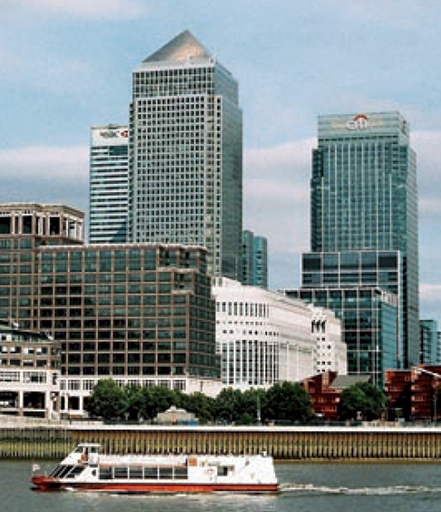4 Daylighting
As well as providing heat, the Sun provides daylight – a commodity that we all take for granted. Replacing it with artificial light was, before the middle of the 20th century, very expensive. With the coming of cheap electricity and efficient lighting, daylight has tended to be neglected.
Houses are frequently designed to make use of natural daylight – in the UK in 2013 domestic lighting accounted for less than 3% of domestic energy consumption.
In some commercial offices, however, lighting can account for up to 30% of the delivered energy use. Modern factory units and hypermarket buildings are built with barely any windows, and some ‘deep-plan’ office buildings, such as those at Canary Wharf in London shown in Figure 10, have plenty of windows on the outside but include many areas on the inside that require continuous lighting, even when the Sun is shining brightly outside.

Although in winter the waste heat from lights can usefully contribute to space heating energy, in summer when there is most light available it can cause overheating, especially in well-insulated buildings. Making the best use of natural light saves both on lighting energy and on the need for air conditioning.
Daylighting design
Many of the design details to make the most of natural daylight can be found in the better quality 19th century buildings.
Activity 4 Lighting in buildings
Think about a few older buildings you have been in. What traditional techniques to enhance lighting can you think of that are used in these buildings?
Answer
Traditional techniques include:
'shallow-plan' design, allowing daylight to penetrate all rooms and corridors light wells in the centre of buildings roof lights
tall windows, which allow light to penetrate deep inside rooms
the use of task lighting directly over workplaces, rather than lighting the whole building interior.
An extreme example is in the small Norwegian town of Rjukan, set deep in a mountain valley, which has installed large steerable mirrors on an adjacent mountain-top to reflect a small, but very welcome, patch of sunlight into the town square.
When artificial light has to be used, it should be used efficiently and turned off as soon as natural lighting is available. Control systems can reduce artificial lighting levels when photoelectric cells detect sufficient natural light. Payback times on these energy conservation techniques can be very short and savings of 50% or more are feasible.
In designing new buildings, compromises need to be made between lighting design and thermal design. Deep-plan office buildings, such as those shown in Figure 10, have a smaller surface area per unit volume than shallow-plan ones, so they will need less heating in winter, but will need more interior lighting energy.
